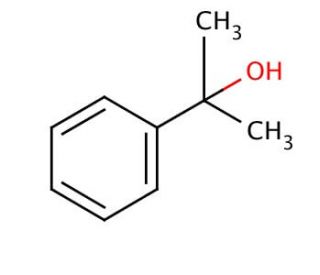

2-Phenyl-2-propanol (CAS 617-94-7)
QUICK LINKS
2-Phenyl-2-propanol is a compound that functions as a chiral building block in organic synthesis. Its mechanism of action involves participating in various chemical reactions, such as Grignard reactions, to form new carbon-carbon bonds. 2-Phenyl-2-Propanol can also act as a ligand in transition metal-catalyzed reactions, facilitating the formation of complex organic molecules. 2-Phenyl-2-propanol can serve as a precursor for the synthesis of intermediates and fine chemicals. Its functional role in experimental applications involves its ability to undergo selective transformations, enabling the creation of diverse molecular structures. 2-Phenyl-2-Propanol′s mechanism of action at the molecular level involves its participation in stereochemical control and the formation of key intermediates in organic synthesis.
2-Phenyl-2-propanol (CAS 617-94-7) References
- Role of THR501 residue in substrate binding and catalytic activity of cytochrome P4501A1. | Cvrk, T. and Strobel, HW. 2001. Arch Biochem Biophys. 389: 31-40. PMID: 11370669
- Cumene oxidation by cis-[RuIV(bpy)2(py)(O)]2+, revisited. | Bryant, JR., et al. 2004. Inorg Chem. 43: 1587-92. PMID: 14966998
- Gas-phase transfer of polymer cross-linking agents and by-products to solid oral pharmaceuticals. | Maus, RG., et al. 2007. J Pharm Biomed Anal. 45: 400-6. PMID: 17686599
- Solvent effects on the AIBN forced degradation of cumene: Implications for forced degradation practices. | Nelson, ED., et al. 2009. J Pharm Sci. 98: 959-69. PMID: 18623222
- Fragrance material review on 2-phenyl-2-propanol. | Scognamiglio, J., et al. 2012. Food Chem Toxicol. 50 Suppl 2: S130-3. PMID: 22033099
- Potential of natural products and their derivatives to control Formosan subterranean termites (Isoptera: Rhinotermitidae). | Raina, A., et al. 2012. J Econ Entomol. 105: 1746-50. PMID: 23156172
- VOC Emissions and Formation Mechanisms from Carbon Nanotube Composites during 3D Printing. | Potter, PM., et al. 2019. Environ Sci Technol. 53: 4364-4370. PMID: 30875473
- Plant growth-promoting and non-promoting rhizobacteria from avocado trees differentially emit volatiles that influence growth of Arabidopsis thaliana. | Gamboa-Becerra, R., et al. 2022. Protoplasma. 259: 835-854. PMID: 34529144
- Characterization and chemical reactivity of room-temperature-stable MnIII-alkylperoxo complexes. | Opalade, AA., et al. 2021. Chem Sci. 12: 12564-12575. PMID: 34703542
- EsigGOBP1: The Key Protein Binding Alpha-Phellandrene in Endoclita signifer Larvae. | Hu, P., et al. 2022. Int J Mol Sci. 23: PMID: 36012538
- Bioremediation of a salty petrochemical wastewater containing bisphenol A by a novel indigenous Pseudomonas pseudoalcaligenes. | Jahanshahi, S., et al. 2022. RSC Adv. 13: 388-398. PMID: 36605645
- The Sequence Characteristics and Binding Properties of the Odorant-Binding Protein 2 of Euplatypus parallelus to Semiochemicals. | Cui, G., et al. 2023. Int J Mol Sci. 24: PMID: 36675226
- [Cleavage of 2-phenylpropan-1-ol and 2-phenylpropan-2-ol-glucuronide, 2 metabolites of isopropylbenzol (Cumol)]. | Goenechea, S., et al. 1986. Z Rechtsmed. 97: 83-8. PMID: 3811631
Ordering Information
| Product Name | Catalog # | UNIT | Price | Qty | FAVORITES | |
2-Phenyl-2-propanol, 5 g | sc-230632 | 5 g | $40.00 | |||
2-Phenyl-2-propanol, 25 g | sc-230632A | 25 g | $93.00 |
